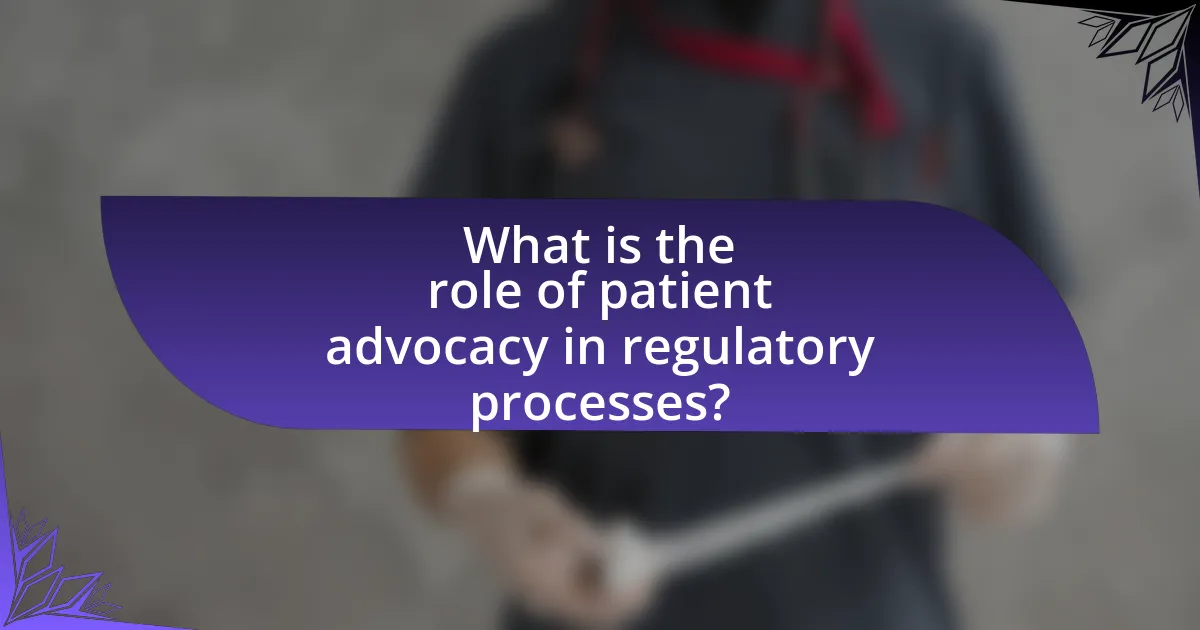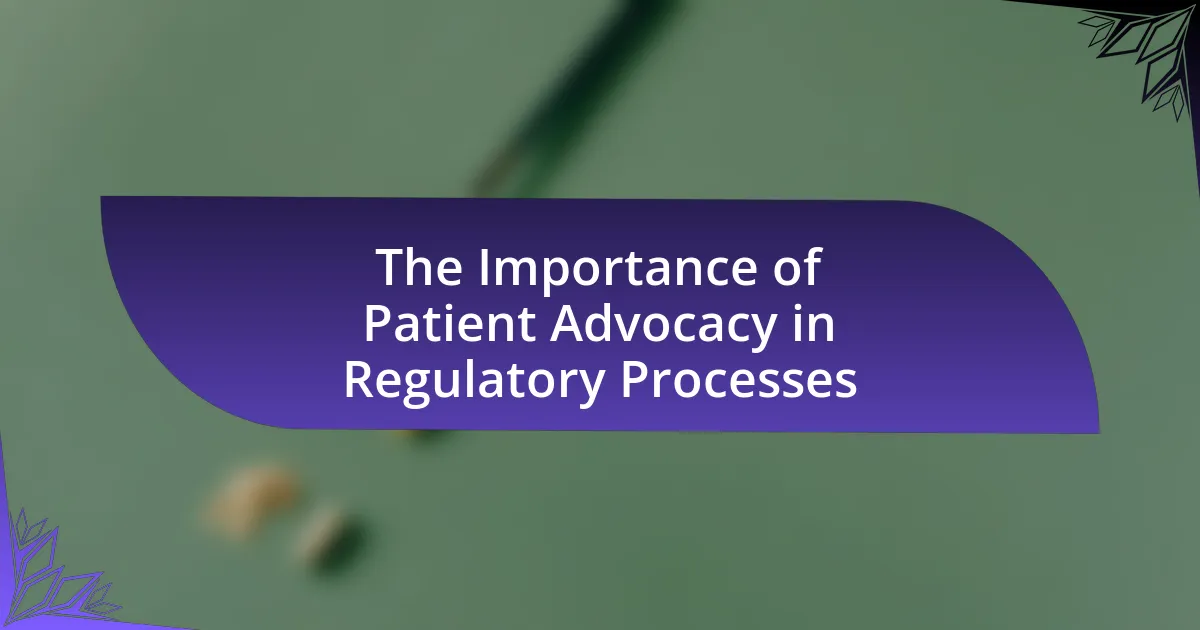Patient advocacy is a vital component of regulatory processes in healthcare, ensuring that patient perspectives and needs are integrated into decision-making. This article examines the influence of patient advocacy on regulatory decision-making, highlighting its role in shaping health policies and improving patient safety and rights. Key components of effective advocacy, communication strategies with regulatory bodies, and the challenges faced by advocates are discussed, along with emerging trends and best practices. The article emphasizes the importance of patient-centered approaches in regulation and the potential for advocacy to enhance healthcare quality and outcomes.

What is the role of patient advocacy in regulatory processes?
Patient advocacy plays a crucial role in regulatory processes by ensuring that the perspectives and needs of patients are considered in decision-making. Patient advocates contribute to the development of regulations by providing insights on patient experiences, which can influence the approval and monitoring of medical products and treatments. For instance, organizations like the Patient-Centered Outcomes Research Institute (PCORI) emphasize the importance of patient input in research and regulatory frameworks, leading to more effective and relevant healthcare solutions. This involvement helps to align regulatory outcomes with patient needs, ultimately improving healthcare quality and safety.
How does patient advocacy influence regulatory decision-making?
Patient advocacy significantly influences regulatory decision-making by ensuring that the perspectives and needs of patients are considered in the development of health policies and regulations. Advocacy groups actively engage with regulatory bodies, providing firsthand accounts of patient experiences, which can shape the understanding of treatment efficacy and safety. For instance, the involvement of patient advocates in the FDA’s Patient-Focused Drug Development initiative has led to the incorporation of patient-reported outcomes in drug approval processes, demonstrating how patient input can directly impact regulatory standards and practices. This integration of patient voices not only enhances the relevance of regulatory decisions but also fosters transparency and accountability within the healthcare system.
What are the key components of effective patient advocacy?
The key components of effective patient advocacy include clear communication, informed consent, and support for patient autonomy. Clear communication ensures that patients understand their health conditions and treatment options, which is essential for making informed decisions. Informed consent involves providing patients with all necessary information regarding their care, allowing them to agree to or refuse treatment based on a comprehensive understanding. Support for patient autonomy emphasizes the importance of respecting patients’ rights to make choices about their own healthcare, which is crucial in fostering trust and collaboration between patients and healthcare providers. These components are vital for enhancing patient engagement and improving health outcomes.
How do patient advocates communicate with regulatory bodies?
Patient advocates communicate with regulatory bodies through formal submissions, public comments, and participation in advisory committees. These methods allow advocates to present patient perspectives, share experiences, and influence policy decisions. For instance, the U.S. Food and Drug Administration (FDA) encourages public input on drug approvals, where advocates can submit comments during open periods, thereby directly impacting regulatory outcomes. Additionally, patient advocates often collaborate with organizations that have established relationships with regulatory agencies, enhancing their ability to convey patient needs effectively.
Why is patient advocacy essential in healthcare regulations?
Patient advocacy is essential in healthcare regulations because it ensures that the voices and needs of patients are represented in policy-making processes. This representation leads to regulations that prioritize patient safety, quality of care, and equitable access to healthcare services. For instance, the Patient Protection and Affordable Care Act of 2010 incorporated patient advocacy to enhance consumer protections and improve healthcare delivery. By actively involving patients in regulatory discussions, healthcare systems can better address real-world challenges and improve health outcomes.
What impact does patient advocacy have on policy outcomes?
Patient advocacy significantly influences policy outcomes by ensuring that the voices and needs of patients are represented in decision-making processes. Advocacy efforts can lead to the development of more patient-centered policies, as seen in the passage of the Affordable Care Act, which incorporated patient feedback to improve healthcare access and quality. Research indicates that when patient advocates engage with policymakers, they can effectively highlight critical issues such as access to treatments and the importance of patient safety, resulting in legislation that better addresses these concerns. For instance, studies have shown that patient advocacy groups played a crucial role in shaping the 21st Century Cures Act, which aimed to accelerate medical product development and bring innovations to patients more quickly.
How does patient advocacy enhance patient safety and rights?
Patient advocacy enhances patient safety and rights by ensuring that patients’ voices are heard and their needs are prioritized within healthcare systems. Advocates work to identify and address potential safety issues, such as medication errors or inadequate care, by actively engaging with healthcare providers and regulatory bodies. For instance, studies have shown that when patients are involved in their care decisions, the likelihood of adverse events decreases significantly, as evidenced by a 2016 report from the Agency for Healthcare Research and Quality, which found that patient engagement can lead to a 30% reduction in hospital readmissions. Additionally, patient advocates help to educate patients about their rights, empowering them to make informed decisions and seek necessary interventions, thereby reinforcing their autonomy and safety in the healthcare environment.

What challenges do patient advocates face in regulatory processes?
Patient advocates face significant challenges in regulatory processes, primarily due to a lack of resources, limited access to information, and insufficient representation in decision-making bodies. These advocates often operate with minimal funding, which restricts their ability to engage effectively with regulatory agencies. Additionally, they frequently encounter barriers in obtaining timely and relevant data about regulatory changes, making it difficult to advocate for patient needs. Furthermore, the complexity of regulatory frameworks can hinder their ability to influence policy effectively, as advocates may not have the necessary expertise or support to navigate these systems. Studies indicate that patient advocacy groups often struggle to secure a seat at the table during critical discussions, which limits their impact on health policy and regulatory outcomes.
How can patient advocates overcome barriers in regulatory environments?
Patient advocates can overcome barriers in regulatory environments by actively engaging with policymakers and utilizing data-driven approaches to influence decision-making. By building coalitions with other stakeholders, advocates can amplify their voices and present unified positions on regulatory issues. For instance, the Patient-Centered Outcomes Research Institute (PCORI) emphasizes the importance of patient engagement in research and policy, demonstrating that informed advocacy can lead to more favorable regulatory outcomes. Furthermore, leveraging real-world evidence and patient testimonials can effectively illustrate the impact of regulations on patient care, thereby persuading regulators to consider patient perspectives in their decisions.
What resources are available to support patient advocates?
Patient advocates can access various resources to enhance their effectiveness, including training programs, online platforms, and support networks. Organizations such as the Patient Advocate Foundation provide educational resources and advocacy training, while the National Patient Advocate Foundation offers tools and guidance for navigating healthcare systems. Additionally, online communities and forums, like PatientsLikeMe, facilitate peer support and information sharing among advocates. These resources are essential for empowering patient advocates to effectively represent patient interests in regulatory processes.
How do advocates navigate complex regulatory frameworks?
Advocates navigate complex regulatory frameworks by employing a combination of strategic knowledge, collaboration, and effective communication. They familiarize themselves with the specific regulations and policies relevant to their cause, often utilizing resources such as legal experts and regulatory guides to understand the intricacies involved. For instance, patient advocates often engage with regulatory bodies like the FDA to influence drug approval processes, ensuring that patient perspectives are considered. This approach is supported by studies showing that advocacy can lead to more patient-centered regulations, as seen in the FDA’s Patient-Focused Drug Development initiative, which incorporates patient input into the regulatory process.
What strategies can enhance the effectiveness of patient advocacy?
Effective patient advocacy can be enhanced through strategies such as building strong partnerships with healthcare providers, utilizing data-driven approaches, and fostering community engagement. Strong partnerships with healthcare providers ensure that advocates have access to accurate information and resources, which can improve communication and collaboration in addressing patient needs. Data-driven approaches, including the use of patient-reported outcomes and health statistics, can provide evidence to support advocacy efforts, making them more persuasive to policymakers. Additionally, fostering community engagement through outreach programs and support groups can empower patients, giving them a voice in the regulatory processes that affect their care. These strategies collectively contribute to a more effective advocacy framework that can influence healthcare policies and improve patient outcomes.
How can collaboration with healthcare professionals improve advocacy efforts?
Collaboration with healthcare professionals can significantly enhance advocacy efforts by leveraging their expertise and credibility to influence policy and regulatory changes. Healthcare professionals possess in-depth knowledge of medical practices and patient needs, which can inform advocacy strategies and ensure that they are grounded in clinical realities. For instance, studies have shown that when healthcare providers engage in advocacy, they can effectively communicate the importance of patient-centered care, leading to more informed decision-making by policymakers. This collaboration can also amplify the voices of patients, as healthcare professionals can serve as trusted advocates who validate patient experiences and needs, thereby increasing the likelihood of successful advocacy outcomes.
What role does education play in empowering patient advocates?
Education plays a crucial role in empowering patient advocates by equipping them with the knowledge and skills necessary to effectively represent patient interests. Through education, advocates gain an understanding of healthcare systems, regulatory processes, and the rights of patients, which enhances their ability to navigate complex medical and legal landscapes. For instance, studies show that trained advocates are more effective in communicating with healthcare providers and policymakers, leading to improved patient outcomes and increased awareness of patient needs. This empowerment through education ultimately fosters a more informed and engaged advocacy community, which is essential for influencing regulatory changes that benefit patients.

How can patient advocacy shape future regulatory practices?
Patient advocacy can significantly shape future regulatory practices by ensuring that the voices and needs of patients are integrated into the decision-making processes of regulatory bodies. This integration can lead to more patient-centered regulations that prioritize safety, efficacy, and accessibility of healthcare products and services. For instance, organizations like the Patient-Centered Outcomes Research Institute (PCORI) have demonstrated that involving patients in research and regulatory discussions leads to outcomes that better reflect patient priorities and experiences. Furthermore, advocacy efforts can influence policy changes, as seen in the FDA’s establishment of the Patient Engagement Advisory Committee, which directly incorporates patient feedback into regulatory considerations. This trend indicates that as patient advocacy continues to grow, it will increasingly drive the development of regulations that are responsive to the actual needs of patients, ultimately enhancing healthcare quality and outcomes.
What trends are emerging in patient advocacy within regulatory processes?
Emerging trends in patient advocacy within regulatory processes include increased collaboration between patients and regulatory agencies, a focus on patient-centered outcomes, and the integration of patient perspectives in drug development and approval processes. Regulatory bodies, such as the FDA, are actively seeking patient input through initiatives like the Patient-Focused Drug Development program, which emphasizes the importance of understanding patient experiences and preferences. This shift is supported by data indicating that incorporating patient feedback can lead to more effective and relevant healthcare solutions, ultimately improving treatment outcomes and patient satisfaction.
How can technology facilitate patient advocacy in regulatory settings?
Technology can facilitate patient advocacy in regulatory settings by enabling efficient communication and data sharing between patients, advocates, and regulatory bodies. Digital platforms, such as online forums and social media, allow patients to voice their concerns and experiences, which can influence regulatory decisions. For instance, the FDA has utilized patient input through initiatives like the Patient-Focused Drug Development program, which collects patient perspectives on treatment benefits and risks, thereby integrating real-world experiences into regulatory assessments. This approach not only empowers patients but also enhances the relevance of regulatory outcomes by aligning them with patient needs and preferences.
What are the implications of patient-centered approaches in regulation?
Patient-centered approaches in regulation enhance healthcare quality and safety by prioritizing the needs and preferences of patients. These approaches lead to more effective regulatory frameworks that incorporate patient feedback, resulting in improved health outcomes and increased patient satisfaction. For instance, the FDA’s Patient-Focused Drug Development initiative actively involves patients in the drug approval process, ensuring that treatments align with their experiences and expectations. This involvement not only fosters transparency but also encourages innovation in therapeutic options, ultimately benefiting public health.
What best practices should patient advocates follow in regulatory processes?
Patient advocates should follow best practices such as understanding regulatory frameworks, engaging with stakeholders, and providing clear, evidence-based input. Understanding regulatory frameworks enables advocates to navigate complex processes effectively, ensuring that patient perspectives are represented. Engaging with stakeholders, including regulatory agencies and industry representatives, fosters collaboration and enhances the credibility of the advocacy efforts. Providing clear, evidence-based input ensures that the concerns and needs of patients are articulated in a manner that is relevant and persuasive, ultimately influencing regulatory decisions. These practices are supported by the increasing recognition of patient input in regulatory guidelines, such as the FDA’s Patient-Focused Drug Development initiative, which emphasizes the importance of incorporating patient experiences into the regulatory process.
How can advocates effectively engage with stakeholders?
Advocates can effectively engage with stakeholders by establishing clear communication channels and fostering collaborative relationships. This involves identifying key stakeholders, understanding their interests and concerns, and actively involving them in discussions and decision-making processes. Research indicates that effective stakeholder engagement leads to improved trust and transparency, which are crucial in regulatory processes. For instance, a study by the World Health Organization highlights that involving stakeholders in health policy development enhances the relevance and acceptance of regulations.
What tips can improve communication between advocates and regulators?
To improve communication between advocates and regulators, establishing regular dialogue through structured meetings is essential. These meetings can facilitate the exchange of information, clarify expectations, and build trust. For instance, the FDA has implemented initiatives like the Patient Engagement Advisory Committee, which allows advocates to share their insights directly with regulators, enhancing mutual understanding and collaboration. Additionally, utilizing clear and accessible language in communications can help bridge knowledge gaps, ensuring that both parties comprehend the issues at hand. This approach is supported by studies indicating that effective communication strategies lead to better regulatory outcomes and more informed decision-making.



